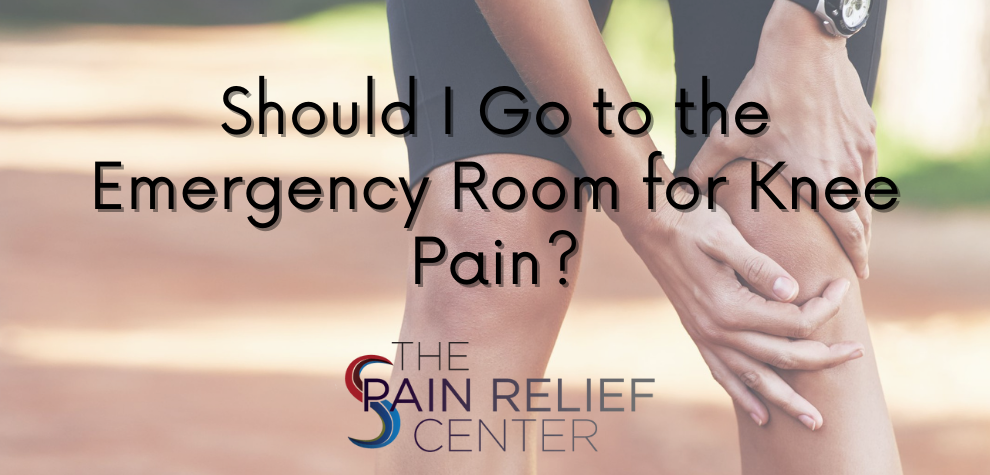The knees are largest joints in the body. Because of that, the knees are extremely susceptible to injury and daily wear and tear. Anyone can suffer from knee pain depending on lifestyle, daily activities, age, and injuries. But frequent or sudden knee pain may make you wonder: should I go to the emergency room for knee pain, or should I try to treat this at home? The Pain Relief Center in Plano not only wants to help you answer this question, but to get rid of your knee pain for good. To expedite your healing and manage your pain, call us today at 214-709-1904.
What Causes Knee Pain?
Knee pain is generally caused by an injury or some kind of inflammation. Listed below are the most common types of injuries and conditions that cause knee pain.
Knee Sprain or Strain
A knee sprain and a strain can sound like the exact same injury, but they are different. A sprain happens when you injure the ligaments around your knee. Meanwhile, a strain happens when you injure the tendons or muscles surrounding the knee. Both types of injuries can be the result of strenuous activity or an accident. Additionally, both injuries can cause pain and swelling.
Hyperextension
Another common cause of knee pain is hyperextension, which is when your knee bends backwards during exercise or strenuous activities. The two ligaments that are usually injured during hyperextension are the anterior cruciate ligament (ACL) and the posterior cruciate ligament (PCL). If you heard a popping sound during your accident, this can indicate hyperextension or torn ligaments.
Runner’s Knee
Poorly aligned knee joints, trauma, and overuse can cause patellofemoral syndrome, also known as runner’s knee. As suggested by the name, runner’s knee is very common among athletes who participate in high-impact sports for years on end. Pain from this type of knee injury generally worsens when squatting, kneeling, or sitting cross-legged. Runner’s knee is commonly treated with rest, pain medicine, and physical therapy. If these treatments are unsuccessful, your doctor may suggest surgery.
Torn Meniscus
The meniscus is a piece of cartilage between your shin and thigh bones that absorbs shock. You may tear your meniscus if you twist your knee unexpectedly. Its shock-absorbing properties will be lost if it’s ripped. This causes discomfort as well as harm to the surrounding areas.
Knee Dislocation
A dislocation happens when the knee bones pop out of place due to an accident. A severe dislocation can also stretch or tear the knee ligaments, arteries, and nerves. Inability to walk, extreme pain, and an obvious deformity can indicate a dislocated knee.
ACL Tear
One of four ligaments that links your thigh and shin is the anterior cruciate ligament (ACL). ACL tears are typical among athletes, specifically basketball, soccer, or football players because they quickly change direction.
Bursitis
Bursae are little fluid-filled sacs that cushion your joints’ bones, tendons, and muscles. Bursae become inflamed in people with bursitis. The inflammation naturally causes discomfort.
Patellar Tendonitis
Patellar tendonitis happens when the kneecap, also known as the patella, and the tendons surrounding it become inflamed.
Fracture
You can break or fracture the bones around your knee in a variety of ways. Fractures are more common in people who have osteoporosis. Additionally, broken bones are common in athletes and children.
Arthritis
There are numerous types of arthritis, but the types that generally cause knee pain are gout and pseudogout. Gout is a painful disorder caused by the formation of uric acid crystals around a joint. It affects the feet and knees the most. Meanwhile, calcium pyrophosphate dihydrate crystals causes pseudogout.
Can I Treat Knee Pain at Home?
Some knee pain is minor and can resolve on its own with at-home-care. You can manage these kinds of knee pain at home:
- Mild to moderate pain after running or walking
- Knee pain from preexisting minor injuries such as mild knee strains
- Mild to moderate pain that appears slowly
How to Treat Knee Pain at Home
The best at home treatment for mild to moderate knee pain is the RICE treatment: rest, ice, compression, and elevation. This treatment is effective for reducing swelling and pain as well as for expediting healing.
Rest
Both light movement and rest are crucial when it comes to healing a minor knee injury. In other words, it’s important to avoid high impact activities such as running and jumping. Instead, try low impact activities like walking, swimming, yoga, or biking. When you’re not moving, it’s important to rest and stay off your feet.
Ice
Make sure to ice your knee a few times per day for approximately 15 to 20 minutes at a time. Icing your knee will help reduce swelling.
Compression
Wrapping an ACE bandage around your injured knee will also help reduce swelling. The bandage should be tight, but not tight enough to cause more pain or swelling.
Elevation
Laying down with your knee elevated on a couple pillows also helps with pain and swelling. Make sure to elevate your knee a few times a day for 15 to 20 minutes.
Pain Medication
Alongside the RICE treatment, you can take over-the-counter NSAIDs to control pain and swelling as well. Common NSAIDs include Advil, Motrin, and Aspirin.
Should I Go to the Emergency Room for Knee Pain?
Sometimes knee pain can indicate a severe injury that you can’t treat at home. But how can you differentiate a minor injury from a major, emergent injury? Both minor and major injuries can cause pain, swelling, and general discomfort that makes you ask yourself: should I go to the emergency room for knee pain? If you have any of the five symptoms listed below, you should certainly see a doctor as soon as possible.
You Can’t Walk Normally
If you can’t walk normally, you can’t put weight on your knee without unbearable pain, or you feel like fainting when you stand, you should go to the ER. Severe pain that prevents you from walking can indicate a broken bone which deserves immediate medical attention. However, if your knee only hurts when you walk on it, you may have sprained or strained your knee instead of breaking it. In this case, you should go to urgent care instead of the ER.
The Pain Doesn’t Go Away
Another red flag when it comes to knee injuries is pain that doesn’t go away after a few days of at home treatment. This doesn’t warrant an ER visit, but you should certainly go to urgent care.
The Pain Gets Worse
If your knee pain gets even worse after the RICE treatment along with pain medications, this is a sign that at home treatment isn’t the right approach. Pain that gradually gets worse indicates a more serious injury. In this case, you should go to urgent care.
The Pain Keeps Coming Back
Knee pain that keeps coming back after extensive at home treatment is certainly worthy of an urgent care visit. Runner’s knee is a common type of knee injury that causes pain to come and go.
Your Knee is Misshapen, Swollen, or Hot
A warm, swollen knee can indicate an infection, especially if you also have a fever. Meanwhile, a misshapen knee indicates a serious injury that won’t heal with at home care. In both of these situations, you should certainly go to the ER because they indicate serious injuries.
What to Expect at an ER Visit for Knee Pain
An ER visit is generally stressful for anyone, especially when you’re in pain from a knee injury. What can make an ER visit worse is not knowing what to expect from the doctors.
Detailed History
Firstly, a doctor will ask for a detailed history to determine the nature and cause of your pain. They will ask questions such as: where is the pain in your knee? What does the pain feel like? How long have you been in pain? How active are you?
Physical Exam
Next, an ER doctor will physically examine your knee to check for swelling, discoloration, temperature, and deformities. Your doctor will also touch around your knee to determine which areas are tender and which areas aren’t.
Scans and Tests
Following the physical exam, your doctor will likely order an X-ray, a CT scan, or an MRI depending on the type of injury they suspect. X-rays show knee fractures and dislocations as well as arthritis. A CT scan is basically a three dimensional X-ray and also shows knee fractures. If your doctor doesn’t suspect a fracture or a dislocation, they may order an MRI because it can show injured ligaments and tendons in the knee.
Fluid Removal
Lastly, your doctor may suggest fluid removal from the knee if necessary. This procedure would only be necessary if you have a joint infection, gout, or arthritis. Fluid removal is usually performed under local anesthesia and can decrease swelling and pain. Additionally, the fluid that a doctor removes can be tested to determine a definite diagnosis.
Call The Pain Relief Center Today
Knee pain specialists at The Pain Relief Center want to make sure that you never have to ask yourself: should I go to the emergency room for knee pain? You may need physical therapy or pain management following your at home or ER treatment, and that’s what we’re here for. Call us today at 214-709-1904 to speak with a joint pain specialist and to begin your journey to a pain-free life.

